“I heard the bells on Christmas Day
Their old, familiar carols play,
And wild and sweet
The words repeat
Of peace on earth, good-will to men!”
These famous words were written in 1863 by Henry Wadsworth Longfellow in his poem Christmas Bells. They became more widely known, nearly a hundred years later, when Bing Crosby recorded them as a Christmas carol.
Church bells, such as this trio spotted in Rome Italy, are often associated with the holiday season. But, as I learned while researching today’s blog post, there’s a lot more to this subject than a catchy tune.
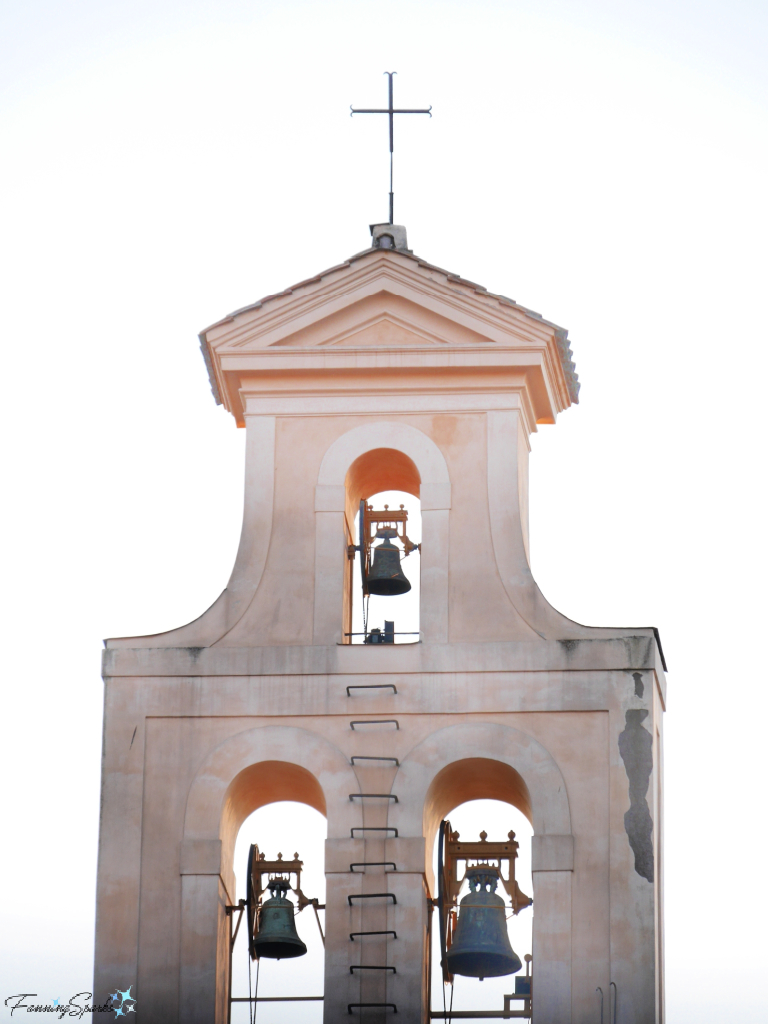
Ringing church bells to mark Christmas and New Year is a cherished custom in many parts of the world. Church bells also bring to mind church services and weddings. According to Wikipedia, “In AD 604, Pope Sabinian officially sanctioned the usage of bells to announce services and call worshippers. By the early Middle Ages, church bells became common in Europe.” Here’s another example—this single bell is from the island of Hydra in Greece.
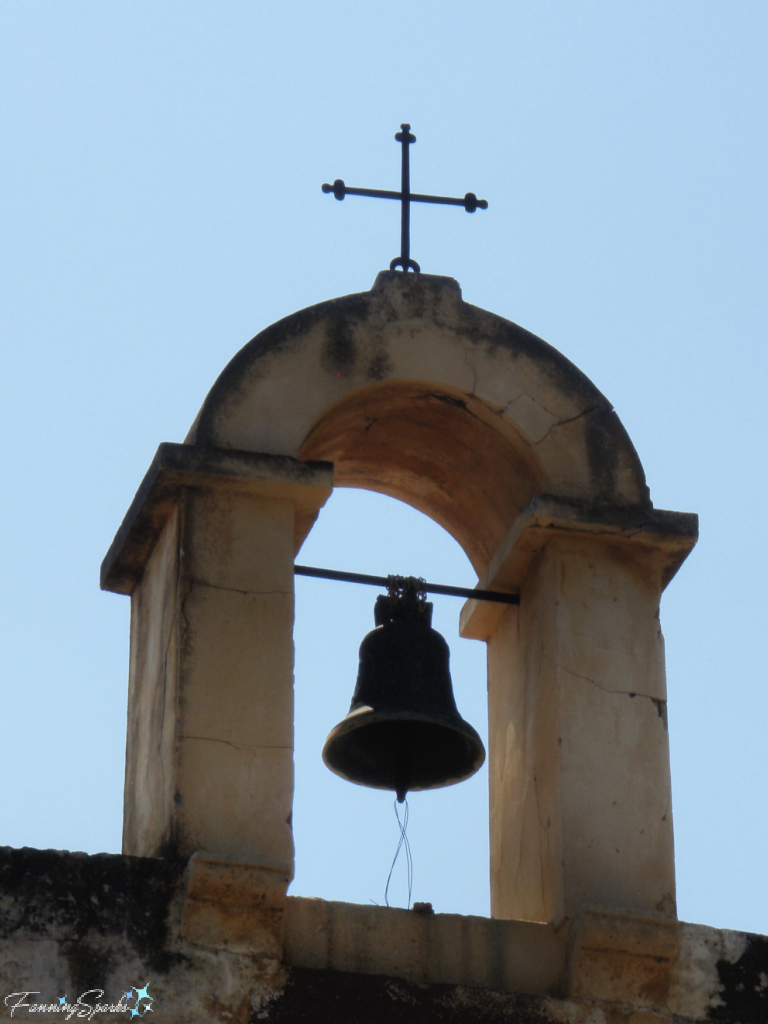
It’s said that in Great Britain nearly everyone lives within hearing range of bells. The bells, according to the Bell Ringing Organization, “call us to wake, to pray, to work, to arms, to feast and, in times of crisis, to come together. Above all, bells are the sound of freedom and peace as in World War II they hung silently until the day they could ring in the peace.”
I discovered this classic church bell tower in Fão Esposende in Portugal.
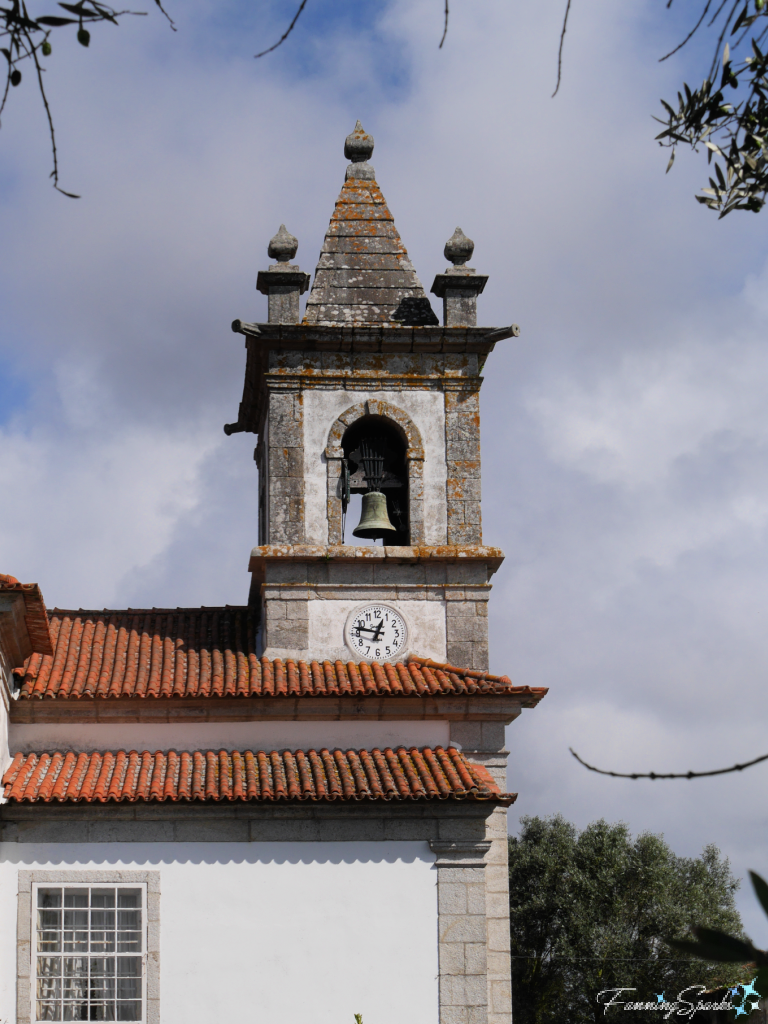
In her book Bells, Bells, Bells, author Bernadine Bailey tells us “In olden times, people believed that bells had supernatural powers to drive out evil as well as to ward off danger. It was commonly thought that demons and ghosts could be scared away by the sound of metal, such as the beating of gongs or the ringing of bells. On Midsummer Eve, when witches were supposed to gather, church bells were rung all night long to drive them away.”
The moon is just barely visible in this photo of a bell tower in Caminha, Portugal.
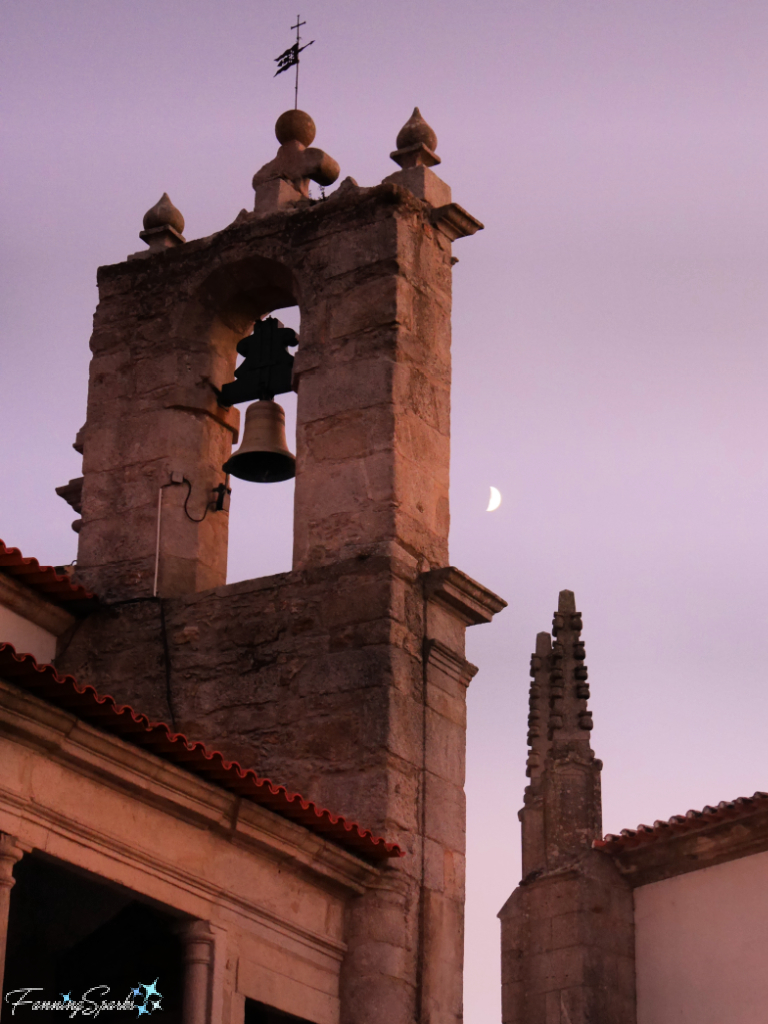
Bailey goes on to explain “It was also believed that bells could have a great effect upon the weather, especially on thunder and lightning that were thought to be controlled by demons. The people felt that these spirits would be frightened by any sound connected with Christian worship, so they rang church bells when a storm was approaching to scare them away.”
I searched my archives for photos of bells and found a surprising variety from our travels in Europe. This early morning shot of the bridge in Avignon, France is one of my all-time favorites but I didn’t realize, until just now, that there are bells on the bridge!
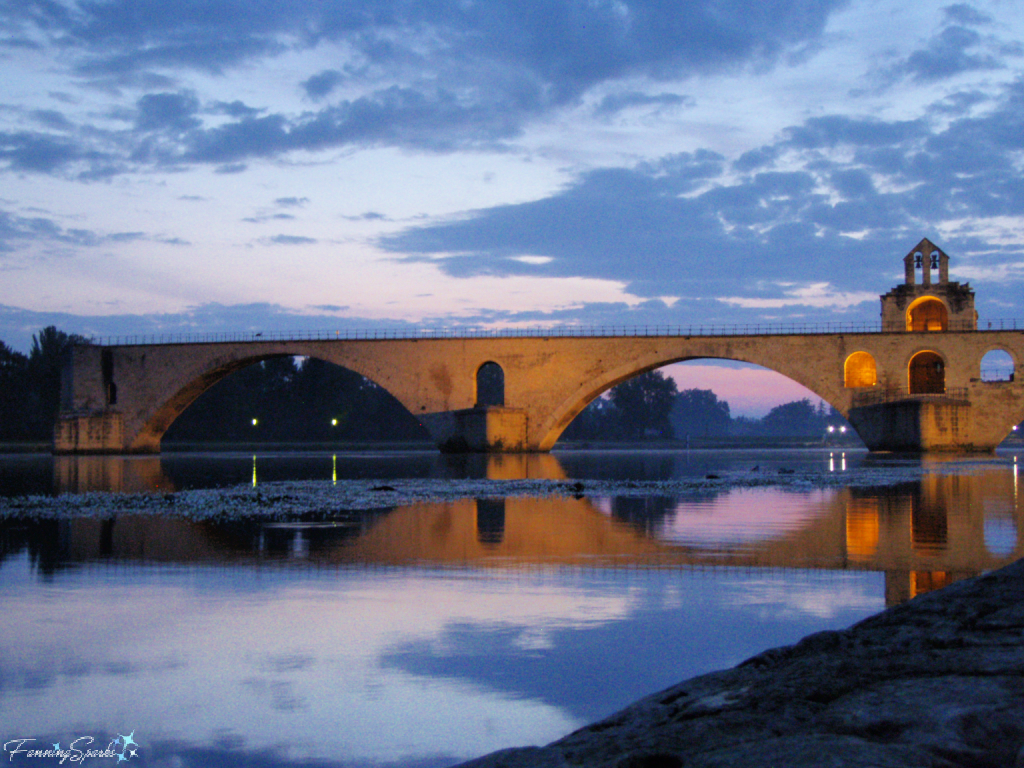
Apparently, at one time there was an active chapel, the Saint Nicholas Chapel, on the bridge.

The soft light of early morning adds a magical glow to the bell towers of this twelfth-century church, Santa Maria a Casavecchia, near Spedaletto in Tuscany Italy.
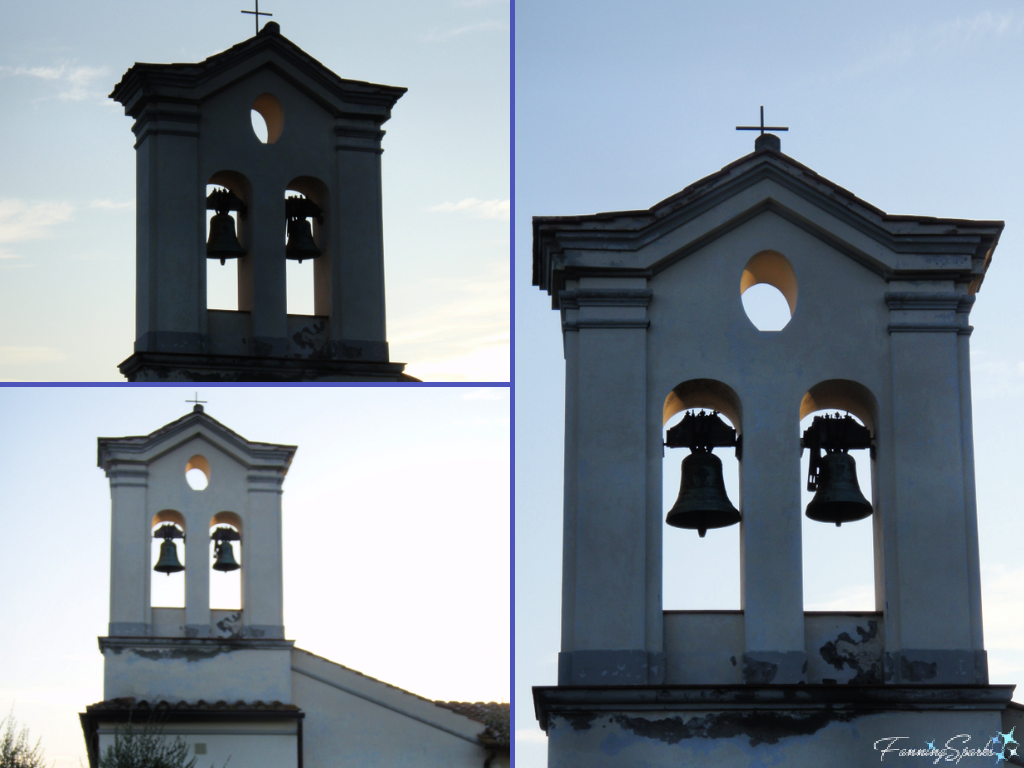
It’s fascinating to examine the various bell towers. Many of them, like this one in Oberhofen, Switzerland, hold clocks as well as bells.
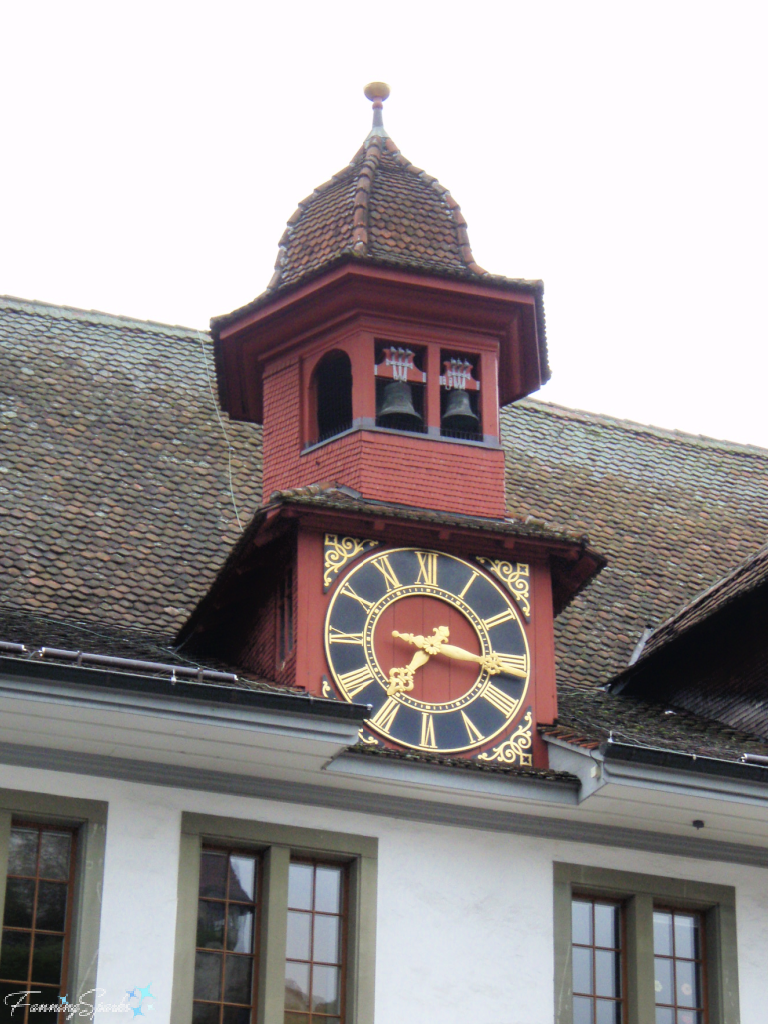
This elaborate bell tower on the Old Castle Tower in Caminha, Portugal also displays a simple clock face.
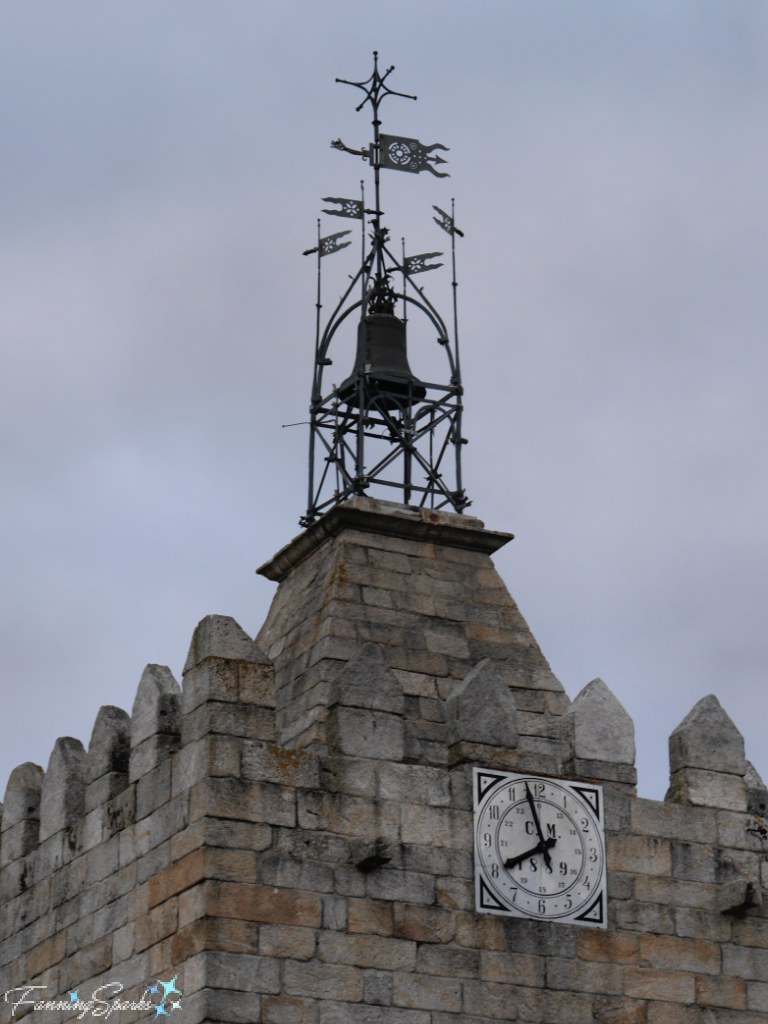
I learned about the connection between bells and clocks when visiting the Ghent Belfry, a well-known landmark and UNESCO World Heritage Site in Belgium, earlier this year (see the blog post Expected and Unexpected Delights of Ghent for a peek into the many charms of this historic city).
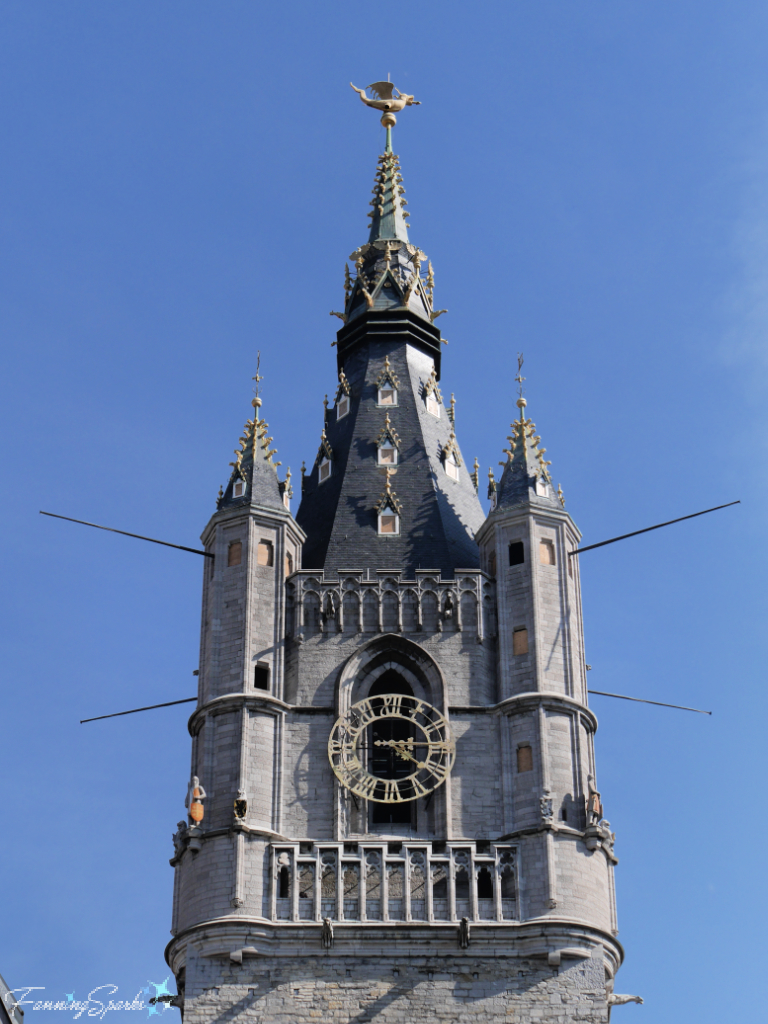
The Ghent Belfry, which dates back to 1313, housed communal bells managed by tower guards. In addition to standing guard to watch for fires, storms, attacks and other danger, the tower guards were bell-ringers. They rang the bells on the hour and for work setting the rhythm of life in the medieval city. Interestingly, because early clocks were wooden and did not track time accurately, the tower guards had to rely on sundials to correct the time several times a day. (For more information about sundials check out the FanningSparks blog post Count Only Sunny Hours.)
“Through the centuries, the belfry served not only as a bell tower to announce the time and various warnings, but also as a fortified watchtower and the place where the documents evidencing the municipal privileges were kept.” says Wikipedia. “The bells in the belfry originally only served a religious purpose. Gradually the bells got a secular role by regulating daily life in the growing medieval city. The hourly chime was preceded by warning signals on three smaller bells with various tones. This was the predecessor of the carillon.”
As explained by author Rev. Dan McDowell, “a carillon is a musical instrument that is typically housed in the bell tower (or belfry) of a church. The instrument consists of at least 23 cast bronze, cup-shaped bells, which are serially played to produce a melody, or sounded together to play a chord. A traditional manual carillon is played by striking a keyboard to activate levers and wires that connect to metal clappers that strike the inside of the bells, allowing the performer on the bells to vary the intensity of the note according to the force applied to the key. … Most modern carillons … are operated electronically.”
It’s possible to view the bells at the top of the Ghent Belfry.

Bells are, of course, not limited to bell towers. In Asia, for instance, it’s common to see wind-bells attached to the eaves of temples and other special structures. “Buddhists especially made use of wind-bells, attaching them profusely by the hundreds or even thousands to the eaves of temples, shrines, and pagodas, causing during breezy moments an almost overwhelming volume of tintinnabulation.” states the Encyclopedia Britannica. “Tintinnabulation”, by the way, means the ringing or sounding of bells or a jingling or tinkling sound as if of bells.
Wind-bells are visible on the eaves of the Five-Storied Pagoda at the Sensoji Temple in Tokyo, Japan.

Interestingly, in 1996, Japan’s Ministry of Environment selected 100 Soundscapes of Japan as part of its efforts to combat noise pollution. The 100 best sounds include 13 different bells (such as temple bells, time bells and tower bells) in addition to waterfalls, streams, vegetation, waves, singing sand and festivals.
I also spotted wind-bells on the Five-Storied Pagoda at the Nikko Toshogu Shrine in Japan.

Here’s another wind-bell sighting. This splendid structure is Wat Lok Moli, a Buddhist temple, in Chiang Mai, Thailand.

In addition to their roles in churches, watch towers and temples, bells serve a surprising number of functions in everyday life. Their shape and size may vary but their ability to attract attention is consistent. Shopkeeper’s bells, for instance, alert the shop owner of a customer’s entrance or exit.
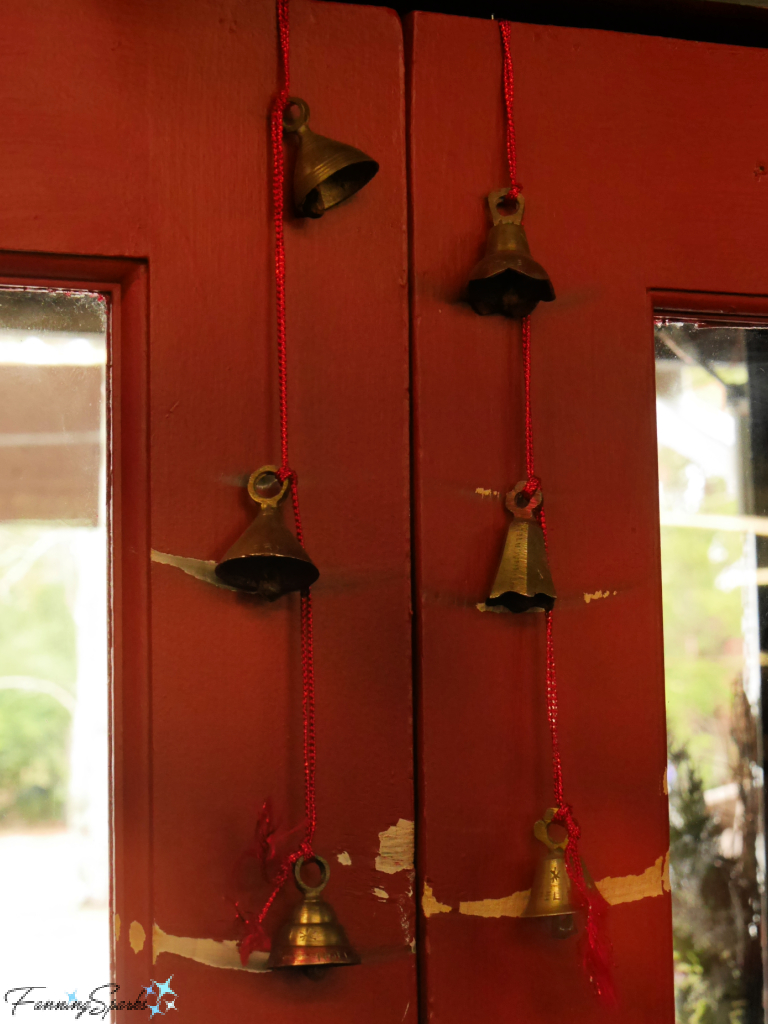
At one time, hand bells or tea bells were used to summon service—much like the privileged Crawleys did in the Downton Abbey TV series! Handbells are still advertised as a great way to call guests to tea, get the family to the dinner table, or get attention from a sick bed.
Here’s an assortment of hand and tea bells from a local vintage shop.
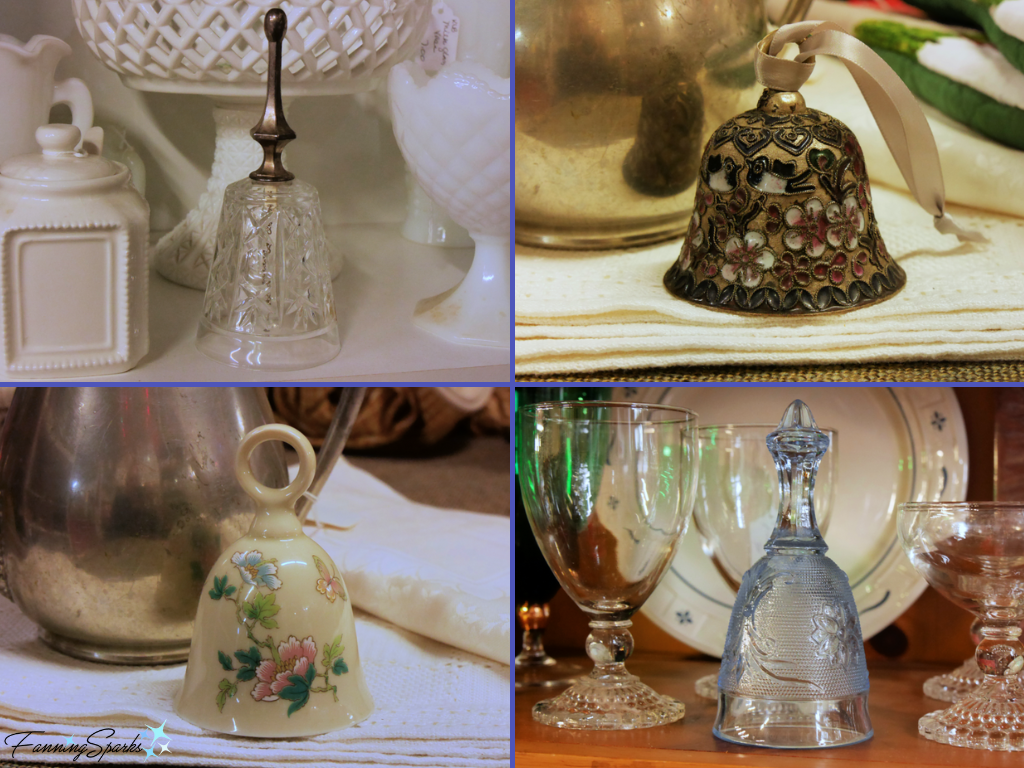
Traditionally, bells are cast in bronze because, as author Elizabeth Starr Hill explains in her book Bells, “the clearest and sweetest bell voice is produced by bronze”. If I’d known that when I spotted this charming array of bronze hand bells at the El Rastro flea market in Madrid, Spain, I would surely have selected one or two to take home.
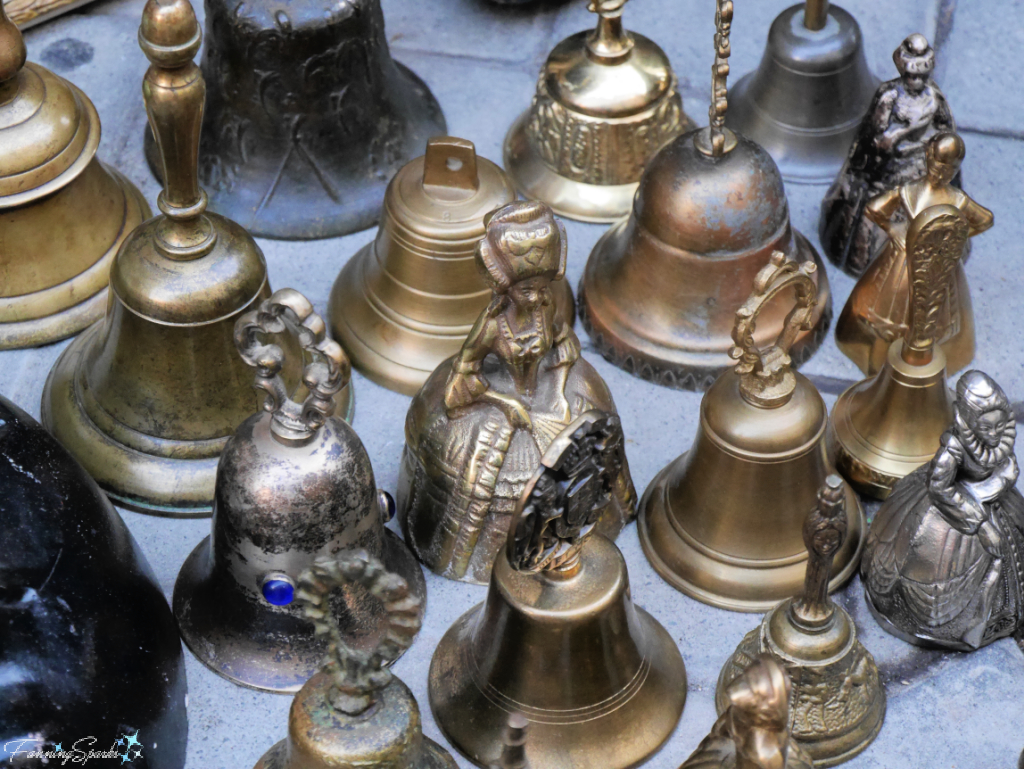
Bells were also on offer at a flea market I visited in Tongeren, Belgium. The variety of decorations on these wall-mounted bells, from roosters to horses to ducks to airplanes to motorcycles to cats, is amazing.
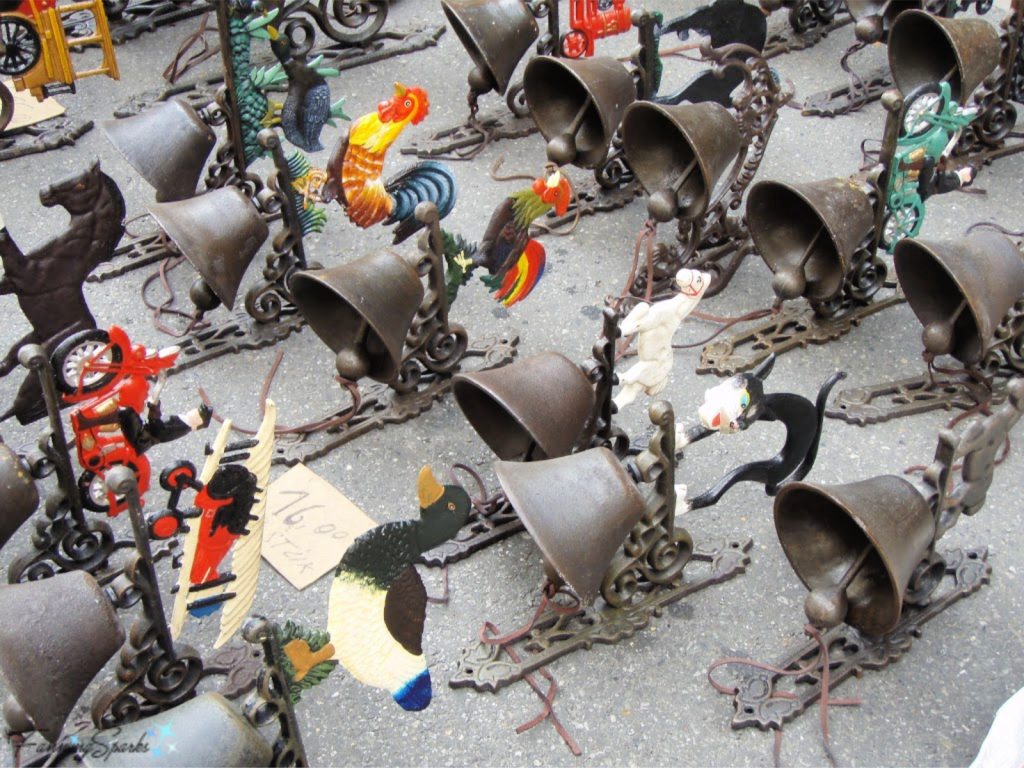
Another type of bell with a long history of important service is the ship’s bell. “Used for signaling, keeping time, and sounding alarms, bells are an important part of a ship’s routine and readiness. Before the advent of the chronometer, time at sea was measured by the trickle of sand through a half-hour glass. One of the ship’s boys had the duty of watching the glass and turning it when the sand had run out. When he turned the glass, he struck the bell as a signal that he had performed this vital function. This age-old practice of sounding the bell on the hour and half hour still holds a place in the modern Navy. The sounding of a ship’s bell can serve as a warning signal to other vessels in poor visibility and fog. In 1858, British naval regulations made this warning function mandatory. Today, maritime law requires all ships to carry an efficient bell.” reports the US Naval History and Heritage Command website.
This is the ship’s bell on the Bluenose II, Nova Scotia’s iconic racing schooner, which I had a chance to tour last fall.
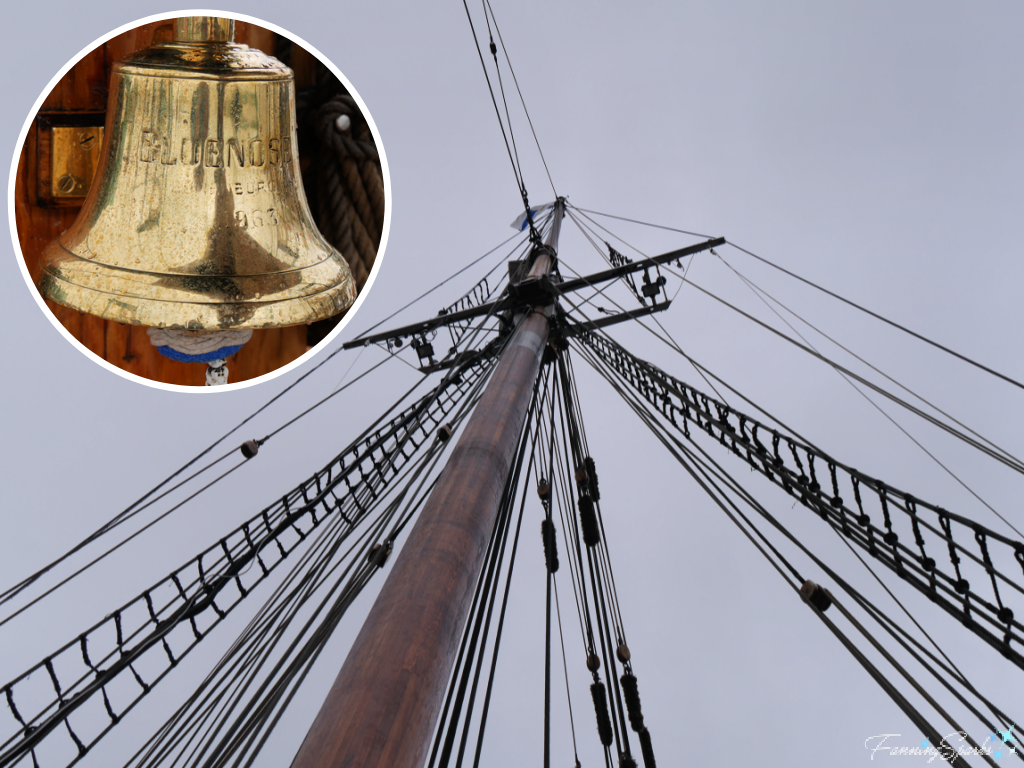
In the same way a ship’s bell can be used to warn other ships of her approach, bicycle bells are used to warn other cyclists and pedestrians. This striking bicycle bell was spotted in Amsterdam, Netherlands.
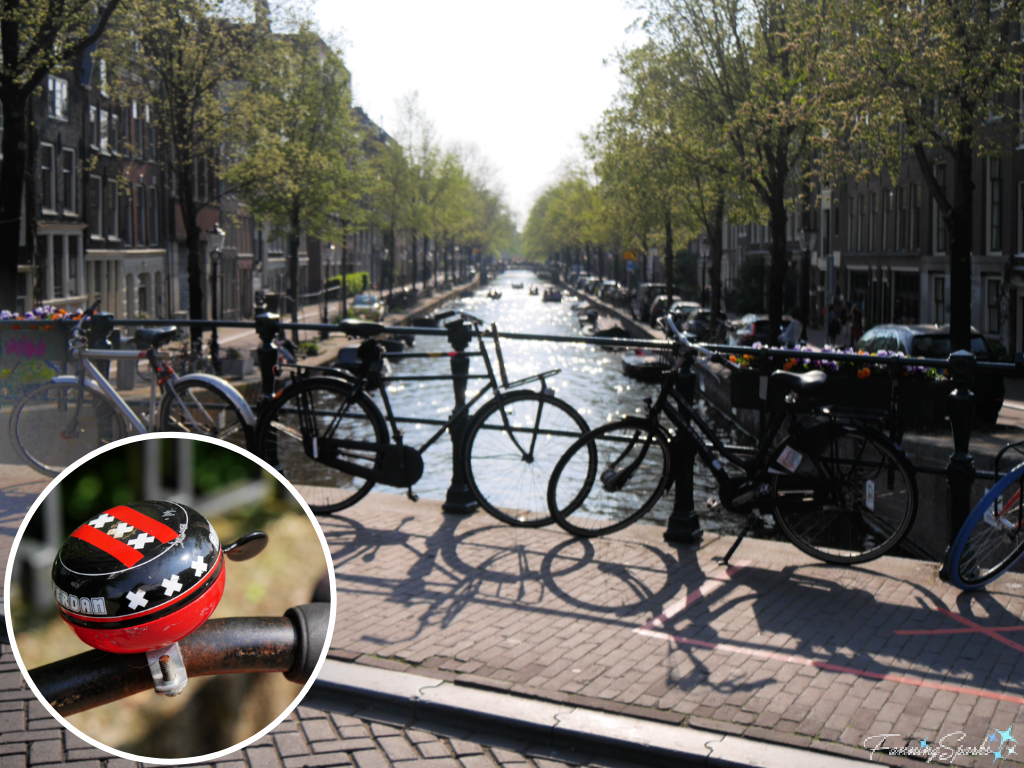
Sleigh bells originated for the same purpose. Wikipedia explains “In the winter in New England in pre-automobile days, it was common to adorn horses’ harnesses with straps bearing bells as a way to avoid collisions at blind intersections, since a horse-drawn sleigh in snow makes almost no noise.” Interestingly, the rhythm of the ever-popular Christmas song Jingle Bells, “mimics that of the trotting horse’s bells”.
This vintage cow bell and strap of sleigh bells, complete with dust and spider webs, was spotted in an old barn.
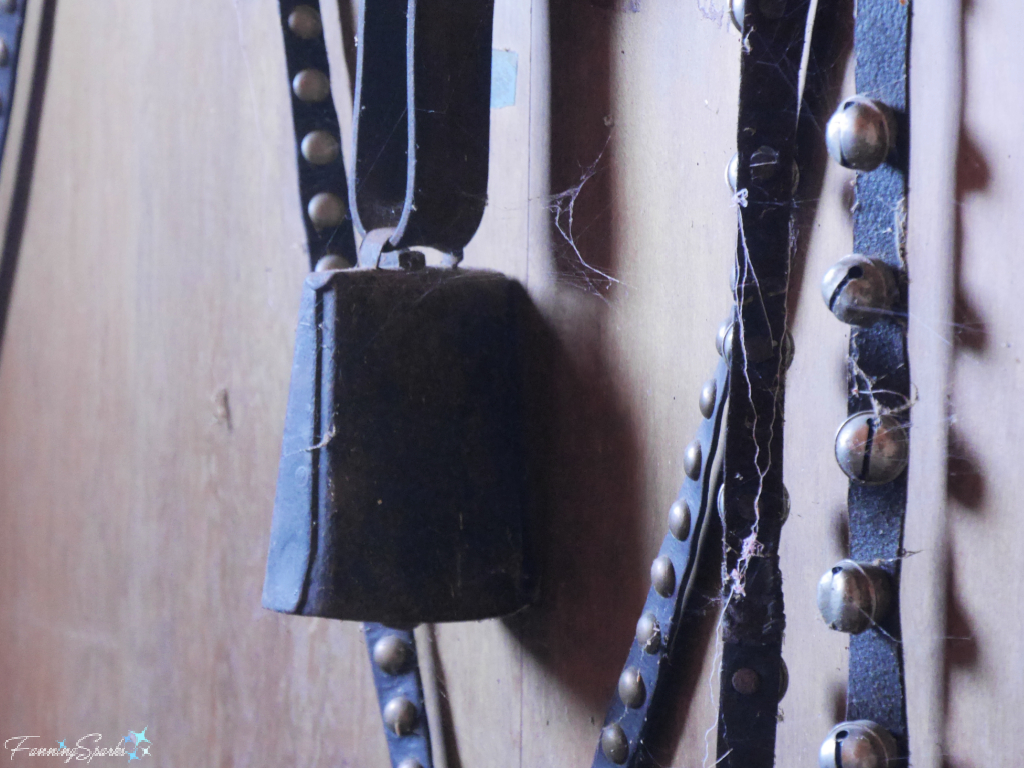
Bells have a long and interesting story to tell. Yet, they go mostly unnoticed until the holiday season. At this time of year, from the ringing of church bells to the jingle of sleigh bells, the sweet sound of bells provides a beautiful, audible reminder of the season’s joy.
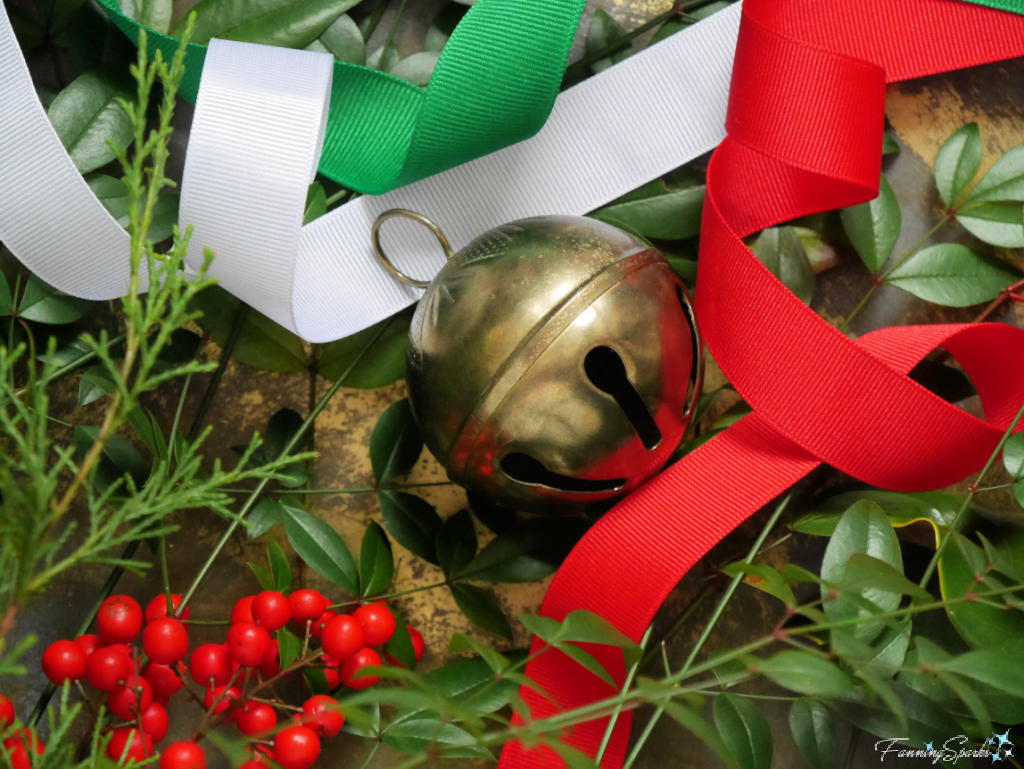
More Info
Check out the following FanningSparks blog posts:
. Expected and Unexpected Delights of Ghent for lots of photos and a summary of my visit to Ghent Belgium
. Count Only Sunny Hours to learn about sun dials.
Several online resources were consulted for today’s blog post including:
. Wikipedia for various topics
. Bell Ringing Association website regarding the history of bell ringing
. Book: Bells, Bells, Bells by Bernadine Bailey which is available here on Archives.org
. The History and Significance of Church Bells by Rev. Dan McDowell, 2014 Olean Times Herald article
. Encyclopedia Britannica website regarding Wind-bells
. Book: Bells by Elizabeth Starr Hill which is available here on Archives.org
. US Naval History and Heritage Command website regarding Ships Bells.
Today’s Takeaways
1. Bells perform a wide variety of functions such as sounding alarms, keeping time, calling to worship, attracting attention, signaling and celebrating special events.
2. Ringing church bells to mark Christmas and New Year is a cherished custom in many parts of the world.
3. The sound of bells, from church bells to sleigh bells, is closely associated with the holiday season.





Comments are closed.